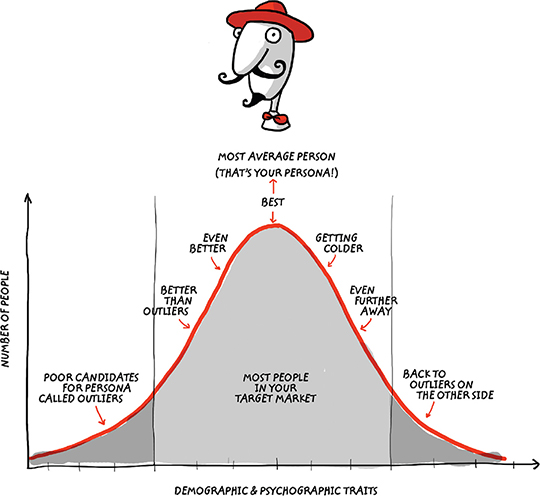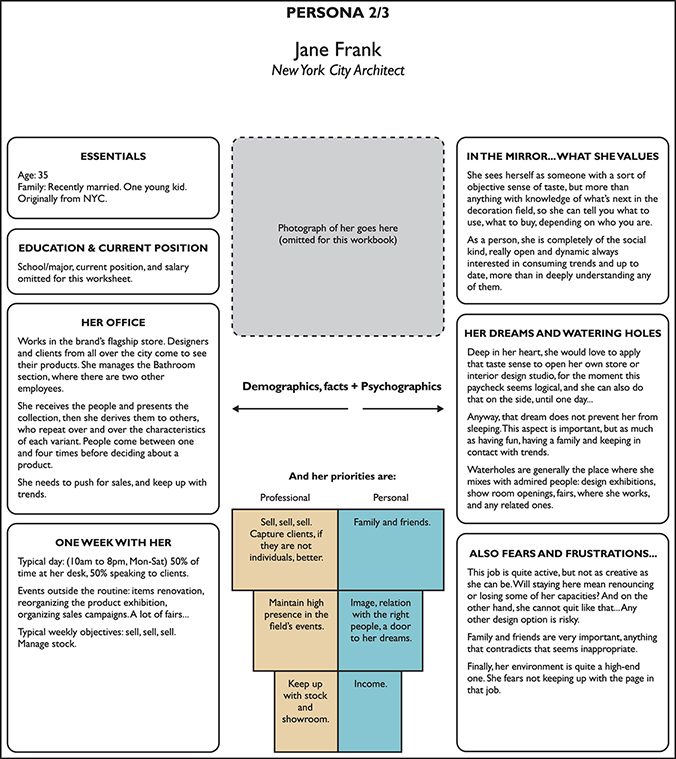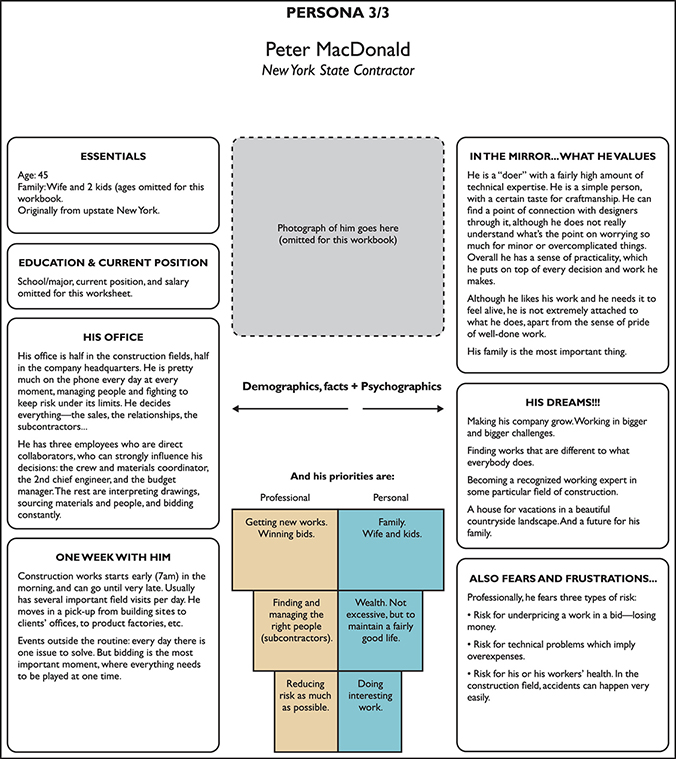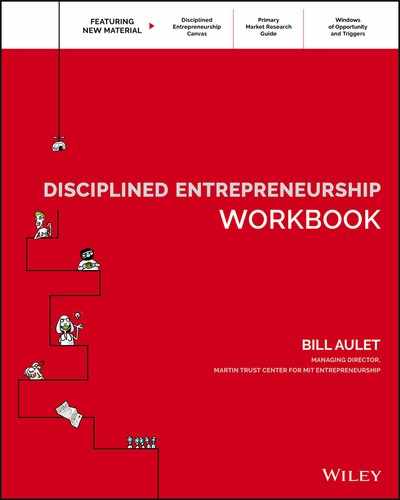STEP 5
Profile the Persona for the Beachhead Market
WHAT IS STEP 5, PROFILE THE PERSONA FOR THE BEACHHEAD MARKET?
Identify one actual real end user in your Beachhead Market who best represents your End User Profile and do a detailed profile on that specific individual.
WHY DO WE DO THIS STEP, AND WHY DO WE DO IT NOW?
The Persona creates great focus in your organization and serves as a touchstone for all decisions going forward.

The Persona clarifies to everyone who is the final arbiter on key decisions on the product.
PROCESS GUIDE
The Persona is very similar to the End User Profile in Step 3, except that it is for one specific individual person and is much more in depth, resulting in an even clearer picture of your target end user.
As a startup, your challenge is to motivate a brand-new team to focus on solving a customer problem/opportunity in a completely new way, and you don’t have the resources to let the team spend valuable time squabbling about which direction to go. Logical arguments based on numbers and concepts have their place, but what really pulls the team together and drives them forward is telling a story. Behavioral economists have known for decades that narratives are the most powerful way to motivate people.1 The Persona is how your startup tells the story of who your customer is and why it matters that you are solving your customer’s pain.
As such it is important that the person you choose for your Persona accurately represents your broader End User Profile from Step 3. You should not just take the first willing person or simply choose someone on your team, but rather find the person who is the best you can get. In technical terms, this person sits at the middle of the bell curve and is not an outlier.
The Persona focuses and motivates you and your team to make the right product design decisions as well as all the other decisions needed around the product (e.g., business model, pricing, distribution, messaging) for you to be successful. It takes conversations that would otherwise be abstract debates and makes them concrete, actionable questions. What would the Persona want and find most valuable?
The Persona is a very simple way to keep the focus in the right place. As I always said at my companies, “Keep the main thing the main thing.”
The downside of this approach is that no one person can fully represent your target end user in all dimensions, but starting with a focused Persona and adjusting when you think it is leading you astray from your End User Profile is better than not having focus at all. Entrepreneurs have limited resources and time, so you need to create action and a strong, unified team to fight the existing hierarchy of status quo and inertia. You can update the Persona later, especially in Step 9, Identify Your Next 10 Customers, so make your best guess now and keep the process moving because you don’t learn without action.

The Persona is the best representative of the broader target market segment in all dimensions.
A question I frequently get is whether a member of the founding team can be the Persona. Teams with members who come from the target customer group start the process with deep domain expertise, which is extremely valuable. In fact, this is often the case for many of my classes’ most successful teams. If you don’t have someone on your team with deep domain expertise in the market you are focused on and who is from the target end user group, you will have to find someone like that and add them to your team early on. When you do, you will be amazed at the insights that person provides.
On the other hand, when you go to the extreme and appoint a member of the founding team as your Persona, you don’t know if you’ve truly found the middle of the bell curve, the person who best exemplifies the target end user group. I have seen it work well, but I’ve also seen it fail spectacularly. You must be constantly vigilant to analyze whether your Persona is a valid choice, and it can be hard for people to step back and realize they are not the best representation of the broader market. The founder’s humility and the strength of the team to hold the founder Persona accountable are key in making it work. In general, I encourage you to use a Persona who is external to your company.
To create the Persona profile, see the two worksheets at the end of this chapter, the General Information on Persona and the Persona Profile for Beachhead Market, which will step you through the information you need to consider in your profile. You may find additional information becomes relevant or some of the fields on the worksheet are not relevant. Make a profile that fits your Persona.
In addition, here are some things to consider when building your Persona:
- It must be a real person. I know this might feel a bit like stalking someone, but marketing researchers have been doing this for years. Keep the details within your team and this can be overcome.
- Make it visual and omnipresent. Your Persona won’t motivate people if it’s a few paragraphs of text sitting on a dusty shelf. Jeff Bezos at Amazon often insists that an empty chair representing the customer be present at important meetings. What would the customer think? How does your decision create value for that person?
- Specificity is good. Definitely err on the side of too much detail rather than too little, especially at first, but then remove the details that don’t add value. If the details explain the mindset of the Persona despite not being directly related to the product, those details are still valuable. However, if they’re not directly related to the product and don’t provide insight about how the Persona thinks, they are just distractions. Take them out!
- It is very important to do this as a team exercise. Just getting the result and then passing it out to the rest of the team is far less effective than having the team involved as the description of the Persona is being created. If possible, have them involved as well in the discussions and observations with the Persona. The more understanding and buy-in you get from your team on the Persona, the more alignment you will have going forward as a company, and that will make all the difference.
Once you have the Persona, you will start to focus on what you can do to add value for that Persona.
GENERAL EXERCISES TO UNDERSTAND CONCEPT
See the back of the book for answers to these questions.
-
Which advertisement do you think will be more effective to get people to donate money? Why?
- According to the World Food Programme, 795 million people in the world do not have enough food to lead a healthy, active life. The vast majority of the world’s hungry people live in developing countries, where 12.9 percent of the population is undernourished. Poor nutrition causes 3.1 million deaths in children under 5 years of age each year, roughly 100 million children in developing countries are underweight, 66 million primary school-age children attend classes hungry across the developing world, and the World Food Programme calculates that $3.2 billion is needed per year to reach all 66 million hungry school-age children. Will you donate today for this cause?
- Raj Shah is 12 years old and lives in New Delhi. Here’s a picture of him and his family. He works in the mornings and evenings to support his mother, Anjali, who is unable to make enough money for her family because she has limited mobility from diabetes, and she also has to take care of her parents. Raj also has to take care of his younger sister, Tanya, who is 7 years old. Raj is trying to go school but having a very hard time because he does not have a nutritious diet, which not only makes him lethargic and unable to focus at school, but can seriously stunt the full development of his brain. Raj has barely eaten anything for 3 weeks now, and certainly nothing healthy, as he is just picking up scraps from what others throw out. There is a good chance that if he does not get a good meal in the next two weeks, he will suffer permanent damage to his brain and body, which will affect his ability to support his extended family. By the way, this is just the story of one child going to school hungry, but there are 66 million of them around the world. Won’t you give $50 to help children like Raj to help themselves and their families? _________________________________________________________________________________________ _________________________________________________________________________________________ _________________________________________________________________________________________ _________________________________________________________________________________________ _________________________________________________________________________________________ _________________________________________________________________________________________ _________________________________________________________________________________________ _________________________________________________________________________________________ _________________________________________________________________________________________
-
What is the bigger challenge for a startup (circle one):
- Having enough time to research and figure out the best strategy.
- Motivating people to keep making progress so that you can generate momentum and convince others to join you.
-
Persona or Not: When you see a spokesperson for a product, like LeBron James for Kia Motors or Jessica Alba for The Honest Company, are they the Persona? If not, who are they?
_________________________________________________________________________________________ _________________________________________________________________________________________ _________________________________________________________________________________________ _________________________________________________________________________________________ _________________________________________________________________________________________ _________________________________________________________________________________________ _________________________________________________________________________________________ _________________________________________________________________________________________
WORKSHEETS
General Information on Persona
1
What is the name of your Persona?
2
Where did you source this person from?
3
What types of biases are possible with this Persona? (e.g., it is a friend/relative who won’t be as honest, the Persona is a potential customer so you might advocate for your product too early instead of staying in inquiry mode)
4
What will you do to mitigate these biases as you work with the Persona?
5
What kind of access do you have to the Persona? (Be careful to use their time wisely because they are not as motivated as you by your process.)
6
What do you see as the strengths of this Persona?
7
What do you see as the weaknesses of this Persona?
8
I agree I will revisit this Persona to see if it is the best Persona on an ongoing basis, especially after Step 9, Identify Your Next 10 Customers, and change if a better one is found and willing.
________ Yes (good answer)
________ No (“No” is not a good answer)
PERSONA PROFILE FOR BEACHHEAD MARKET
Add a visual image of the Persona here

Name
Address
E-mail and phone
Title (if appropriate)
If business-to-business (B2B), where they exist in the overall org chart
Demographics:
Gender
Age
Income
Education level
Education specifics (schools, majors, awards, etc.)
Employment History (companies, jobs, awards, etc.)
Marital status
Kids and other family info
Ethnicity
Political affiliations
Other demographic 1:
Other demographic 2:
Other demographic 3:
Other demographic 4:
Psychographics:
Why do they do this job or live the life they do?
Hobbies
Heroes
Aspirations in life
Fears in life
Personality traits
Interesting habits
Other psychographic 1:
Other psychographic 2:
Other psychographic 3:
Other psychographic 4:
Proxy Products (which products have the highest correlation with your Persona)
Is there a product or products that the Persona needs to have in order to get benefit from yours?
Are there products the Persona uses that embody the psychographics and demographics from the end user profile?
Any other unusual or interesting products of note that the Persona has?
Watering Holes (real or virtual places where the Persona interacts with others like him or her):
Favorite sources for news (e.g., which newspapers, TV shows, websites, blogs)
Places where Persona congregates with other similar people
Associations Persona belongs to and the importance of each
Where does the Persona go for expert advice and/or to get questions answered?
Day in the Life (describe a day in the life of the end user and what is going on in this person’s head):
What are the typical tasks the Persona does each day, with the amount of time associated with each?
Which of these typical tasks are habits?
Which require the most effort?
Which does the Persona enjoy?
Which does the Persona not enjoy?
What makes it a good day for the Persona?
What makes it a bad day?
Who is the Persona trying to please the most?
What is the top priority of the person/people the Persona is trying to please?
Priorities:
Priorities (what are your Persona’s priorities—focus first on biggest fears, then biggest motivations—and assign a weighting to each so that it adds up to 100)
1. _________________ Weighting:__________
2. _________________ Weighting:__________
3. _________________ Weighting:__________
4. _________________ Weighting:__________
5. _________________ Weighting:__________
Now, revisit the General Information worksheet and update as needed, especially for items 3, 4, 6, and 7.
Note: These worksheets are meant to guide you but not constrain you. The Persona should paint a rich picture and convey important information about your target market, so feel free to customize this worksheet as appropriate.
ADVANCED TOPIC: PERSONA PROFILES FOR MULTISIDED END USER MARKET
How do you build a Persona profile when you have multiple types of end users for your startup, such as with the increasingly common platforms being built today? The fundamental concept is the same, designating one Persona for each type of end user, but the Persona profiles must be coordinated and consistent with each other.
Awa Kone, Jeronimo van Schendel, Lisa Tacoronte, and Benedita Sampaio e Mello took my class at MIT and worked on a project to create a platform, dubbed “BuildLine,” to help designers, contractors, and suppliers to better collaborate when turning ideas into tangible products by making relevant peer connections and facilitating the project management process.
While the team had some significant domain expertise in this field, they chose wisely to make the Personas people other than themselves. You will see excellent Personas for all three sides of the proposed new venture (but not perfect, as they never are, especially for a one-semester course where so much has to be covered).
You’ll notice how they handled and coordinated all three sides of the end user market. I really like the detail summarized in one slide for each Persona, so you get a rich understanding of each Persona and can quickly determine what is most important to each, which is highly beneficial when you have to make decisions keeping three Personas in mind instead of just one.
I would have liked to see more on product proxies and watering holes, and at times I felt like their profiles veered more toward advocacy for the product as opposed to focusing solely on understanding who the Personas are, but all in all, they did a tremendous job!
First, an overview of the players in BuildLine:

Then, the three Personas for BuildLine:



